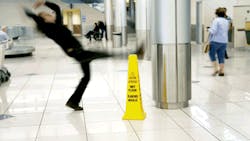According to the Montgomery Insurance Company, a 150-year-old insurance company based in Charlotte, N.C., several myths and misunderstandings surround the issue of slip and fall accidents. These misconceptions include the following:
Shiny floors are less slip resistant than less shiny floors. A floor's shine rarely has anything to do with how safe it is or its slip resistance.
Buffing or burnishing a floor decreases a floor’s slip resistance. According to the insurance company, "Floor surfaces tend to increase in [slip] resistance if the floor is [properly] buffed."
The greater the slip resistance, the safer the floor is. If the slip resistance is too high, "maintenance costs [can] go up" because soil is attracted to the floor. Additionally, a floor with very high slip resistance may be "tacky," which can lead to a slip and fall accident.
Newly applied floor finishes are less slip resistant than aged finishes. Once again, usually the opposite is true. The newly applied floor finish can increase the floor's slip resistance, which may have begun to wear off with the old finish.
Further, the insurance company reports, "Over time, a thin film of soil or some other type of slippery substance can cause floors to become slippery, especially when wet." The insurance company recommends frequent cleaning of the mop and bucket to help prevent "residue from collecting on the cleaning materials."
However, Matt Morrison, the communications manager for Kaivac Inc., which offers cleaning systems, mop-and-bucket cleaning can cause other issues. “I some cases, this 'film' develops due to the actual mopping procedure," says Morrison. He suggests a different approach: using a trolley bucket system that dispenses fresh cleaning solution directly onto the floor that then is collected through a squeegee and vacuum system. This way, liquids, soils and residue are removed completely from the floor.
“The professional cleaning industry must be aware that some of the tools we have historically used to clean floors can actually be contributing to [slip and fall] problems instead of alleviating them,” said Morrison.
About the Author

Sandy Smith
Sandy Smith is the former content director of EHS Today, and is currently the EHSQ content & community lead at Intelex Technologies Inc. She has written about occupational safety and health and environmental issues since 1990.
